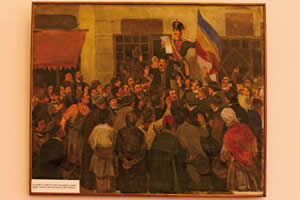Bring home the revolution
Fighting for civil rights, justice and against corruption, Romania’s 1848 revolution has lessons for today, writes Michael Bird, as a new exhibition opens in Bucharest’s History Museum
 |
|
|||||||||||||
Images of rousing peasants draped in the yellow, blue and red of the Romanian flag emblazoned with the words ‘Egality, Fraternity, Justice’ greet visitors to this timely exhibition celerbrating Romania’s valiant attempt at self-determination from the influence of neighbouring empires.
Having sifted through the treasures and bric-a-brac from the National Museum of History, the curators have displayed documents, artefacts and an impressive throne carved with the Wallachian eagle from the period of 1848 on the Romanian revolution’s 160th anniversary.
This celebrates the Wallachian uprising against Russian supervision and Turkish suzerainty and the corrupt boyar system, as well as partner movements in Moldavia and Transylvania.
Young intellectuals, many of whom were freemasons, and insurgent soldiers threw out the Wallachian leader and imperial stooge Prince Bibescu, replacing him with a provisional government. They then passed a series of reforms, many announced in the prescient Proclamation of Islaz and a new system modelled on France’s second republic. A model of the town hall in Craiova where the document was signed is in the exhibition.
The list includes aims and ambitions which are still relevant today, such as civil rights, universal taxation, freedom of the press and greater rights for the Roma minority.
However, in another familiar twist to historians of the country, disputes began over how much land to give back to the peasants. Subsequently, the revolutionaries began to turn on one another.
The movement was quashed by Russia and the Ottomans, with the revolutionaries disappearing into exile. Nevertheless the eastern empires were always extending too far and Romania quietly began to realise most of the targets set out by the revolution. This national unity paved the way for eventual independence in 1877, albeit with a Hohenzollern firmly seated on the throne.
Some of the artefacts, such as signet rings, prison chains, boxes and pens, are little more than random paraphernalia from the period. Meanwhile the exhibition offers little context or coherence and the only information is available in Romanian.
However the impressive faded tricolour flags and Transylvanian revolutionary Avram Iancu’s tiny canon from his vanquished partisans should offer an inspiring cue to any budding new revolutionaries looking to enhance the civil, judicial and minority rights of a nation still in transition.
“1848 Romanian Revolution”
12 Calea Victoriei
Open: Wednesday to Sunday 10-18 hrs

















